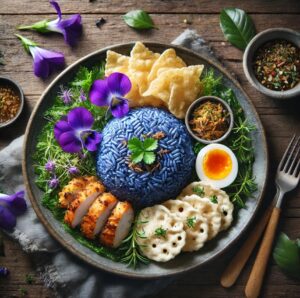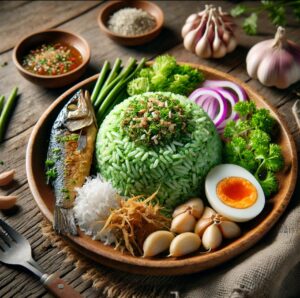Nasi Kerabu and Khao Jam are two iconic rice dishes from Malaysia and Thailand, respectively. Both are visually striking with their blue-colored rice, aromatic herbs, and an array of accompaniments. While they share similarities in ingredients and preparation methods, they also have distinct cultural and culinary differences. This article explores their origins, ingredients, preparation, and how they reflect the food traditions of their respective regions.
Origins and Cultural Significance
Nasi Kerabu originates from the East Coast of Malaysia, particularly the states of Kelantan and Terengganu. It is deeply ingrained in the local food culture and is considered a staple of Malay cuisine. This dish is more than just a meal—it represents the rich culinary heritage of the region, showcasing the influence of traditional Malay cooking techniques and locally available ingredients.
The defining feature of Nasi Kerabu is its striking blue rice, which gets its color from butterfly pea flowers (bunga telang). This natural dye has been used for generations in Kelantanese cuisine and is believed to have health benefits. While the blue version is the most iconic, other variations exist, including rice tinted yellow with turmeric or served plain white.
What makes Nasi Kerabu particularly unique is its emphasis on fresh, raw ingredients. It is often served with a variety of ulam (Malay-style salad), which consists of finely chopped herbs and vegetables such as torch ginger, lemongrass, and basil. This reflects the Malay love for fresh, aromatic flavors and highlights the importance of natural, locally sourced produce in traditional cooking.
Another key element of Nasi Kerabu is its strong, bold flavors, achieved through the use of fermented ingredients such as budu, a pungent anchovy-based sauce that is a hallmark of Kelantanese cuisine. Budu adds depth and umami to the dish, complementing the freshness of the herbs and the smokiness of the grilled or fried proteins typically served alongside the rice. Popular accompaniments include grilled chicken, fried fish, salted egg, and crispy fish crackers, each contributing to the diverse textures and flavors of the dish.
Historically, Nasi Kerabu was a dish enjoyed by farmers and fishermen, as it provided a balanced meal packed with protein, fiber, and essential nutrients. Over time, it has become a beloved dish across Malaysia, with modern variations appearing in urban areas and restaurants throughout the country. Despite its widespread popularity, the dish remains closely tied to its Kelantanese roots, with the best versions still found in traditional warungs (small roadside eateries) in Kelantan and Terengganu.
Ultimately, Nasi Kerabu is more than just a dish—it is a cultural symbol of Malaysia’s East Coast, embodying the Malay appreciation for fresh herbs, fermented flavors, and complex, harmonious taste profiles.
Khao Jam (ข้าวยำ) is a traditional Southern Thai dish that holds deep cultural significance, especially among the Thai-Muslim communities of the region. This dish is widely consumed in the provinces of Pattani, Yala, and Narathiwat, areas that have long been influenced by both Thai and Malay culinary traditions. The name “Khao Jam” translates to “mixed rice,” highlighting the dish’s defining characteristic—an intricate blend of fresh herbs, seasonings, and aromatic rice, all carefully combined to create a balanced and refreshing meal.
Khao Jam stands out from other Thai rice dishes due to its distinctive green-tinted rice, which is infused with an herbal paste made from a variety of fresh ingredients, including pandan leaves, kaffir lime leaves, lemongrass, and turmeric. These herbs not only give the rice its characteristic color but also provide a fragrant aroma and subtle earthy flavors. The use of natural ingredients in both the rice and its accompaniments reflects the deep connection between Southern Thai cuisine and the region’s abundant natural resources.
One of the most important components of Khao Jam is its assortment of fresh, finely chopped herbs and vegetables. Unlike many other Thai rice dishes, which often emphasize stir-fried or cooked ingredients, Khao Jam relies heavily on raw elements such as bean sprouts, long beans, shredded kaffir lime leaves, and finely sliced lemongrass. These ingredients contribute to the dish’s crisp texture and vibrant taste, making it a refreshing meal, particularly in the hot and humid climate of Southern Thailand.
A crucial element that enhances the flavor of Khao Jam is the use of fermented and umami-rich seasonings, particularly nam budu, a fermented fish sauce that is a staple in Southern Thai cooking. Nam budu adds depth to the dish, bringing a salty, savory, and slightly pungent note that complements the freshness of the herbs. Traditionally, diners mix the rice with the sauce and the other ingredients just before eating, ensuring that every bite is infused with a harmonious blend of flavors.
Protein elements in Khao Jam vary but often include smoked or grilled fish, such as kembong (Indian mackerel), which provides a rich, slightly smoky contrast to the fresh and zesty components of the dish. The dish is commonly served with a salted egg, which adds creaminess and a hint of briny richness, balancing the overall taste profile. Additionally, toasted coconut and dried shrimp are sometimes sprinkled on top, further enhancing the texture and umami notes.
Despite the geographical proximity of Southern Thailand to Malaysia, Khao Jam remains distinct from its Malaysian counterpart, Nasi Kerabu. While both dishes share similarities, such as their reliance on fresh herbs, fermented fish sauces, and herbal rice, Khao Jam is more finely chopped and often includes a wider variety of raw ingredients. Additionally, the way the dish is mixed and eaten—where all elements are blended together just before consumption—differs from the more structured presentation of Nasi Kerabu.
Historically, Khao Jam has been a dish of the working class, enjoyed by farmers, fishermen, and laborers who needed a nutritious, well-balanced meal that could be easily prepared with locally available ingredients. Today, it remains a beloved staple in Southern Thai households and is commonly found in local markets, street food stalls, and traditional restaurants across the region. Many Thai-Muslim families continue to prepare Khao Jam using age-old recipes passed down through generations, preserving its authenticity and cultural significance.
In essence, Khao Jam is more than just a meal—it is a representation of the rich culinary heritage of Southern Thailand, shaped by the region’s diverse cultural influences and abundant natural ingredients. It embodies the perfect balance of flavors, textures, and aromas, making it a truly unique dish in the world of Thai cuisine.
Ingredients and Preparation
Rice Base
Both dishes use blue-colored rice, traditionally tinted with butterfly pea flower (Clitoria ternatea). However, the rice preparation differs slightly:
- Nasi Kerabu: The rice is usually steamed and sometimes mixed with coconut milk for a richer flavor. The blue tint comes from soaking the butterfly pea flowers in water before cooking the rice.
- Khao Jam: The rice is usually boiled and mixed with various herbal pastes, making it slightly darker and more infused with earthy flavors compared to Nasi Kerabu.
Herbs and Vegetables
Both dishes emphasize fresh herbs and vegetables, but their selections differ:
- Nasi Kerabu: Includes finely shredded herbs like ulam raja (Cosmos caudatus), turmeric leaves, and kaffir lime leaves, along with raw bean sprouts, cucumbers, and long beans.
- Khao Jam: Features similar fresh greens but also includes grated coconut and lemongrass for additional aroma and texture. Thai cuisine often incorporates shredded kaffir lime leaves and green mango for a tangy touch.
Condiments and Accompaniments
While both dishes include sambal and protein toppings, their flavors and textures differ:
- Nasi Kerabu is typically served with budu, a fermented anchovy sauce unique to Kelantanese cuisine, giving it a deep umami flavor. It also comes with spicy sambal, salted eggs, crispy keropok (fish crackers), and solok lada (stuffed chili with fish paste).
- Khao Jam is commonly paired with nam budu, a Thai-style fermented fish sauce similar to Malaysia’s budu but often mixed with lime juice, lemongrass, and chili for a more pronounced tang. It is also topped with grated coconut, dried shrimp, and sometimes a hard-boiled egg.
Protein Options
Both dishes can be enjoyed with various proteins, including:
- Nasi Kerabu: Grilled or fried fish (such as ikan percik), ayam percik (grilled spiced chicken), or beef rendang.
- Khao Jam: Fried fish, dried shrimp, or Thai-style grilled chicken.
Flavor Profile and Eating Experience
- Nasi Kerabu has a rich and umami-heavy taste due to the use of fermented sauces, coconut milk, and grilled meats. The combination of crunchy vegetables, spicy sambal, and savory fish crackers creates a complex textural contrast.
- Khao Jam has a lighter, tangier, and herbier flavor because of the addition of shredded lime leaves, lemongrass, and green mango. The grated coconut gives it a subtle sweetness, while the dried shrimp adds a unique briny taste.
Summary of Nasi Kerabu and Khao Jam
While Nasi Kerabu and Khao Jam may look similar at first glance, their flavors and accompaniments highlight the distinct food cultures of Malaysia and Thailand. Nasi Kerabu leans towards rich, savory, and spicy elements, while Khao Jam offers a herby, tangy, and slightly sweet experience. Both dishes, however, celebrate fresh ingredients and the art of combining flavors, making them beloved staples in their respective regions.
If you enjoy exploring Southeast Asian cuisine, trying both dishes is a must to appreciate the unique blend of herbs, spices, and culinary traditions they bring to the table.


